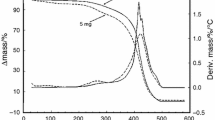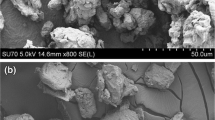Abstract
Four common beans (black, kidney, great northern, and pinto) were extracted with hexane and found to contain about 2% triacylglycerols. The fatty acids in these bean oils were mainly linolenic (41.7–46 wt%), linoleic (24.1–33.4 wt%), palmitic (10.7–12.7 wt%) and oleic (5.2–9.5 wt%). Because of the high levels of polyunsaturated fatty acids, the bean oils had iodine values between 174 and 177 g/100 g (compared to 130 g/100 g for soybean oil). Yet, the bean oils exhibited high oxidative stability due to the presence of high amounts of tocopherols (2,670–2,970 ppm). The bean oils had lower pour points (−18 to −11 °C) compared to −9 °C for soybean oil. Among the four bean oils, kidney bean oil had the highest acid value (15.4 mg KOH/g) and kinematic viscosities over a wide range of temperatures.


Similar content being viewed by others
References
Geil PB, Anderson JW (1994) Nutrition and health implications of dry beans: a review. J Am Coll Nutr 13:549–558
Azevedo L, Gomes JC, Stringheta PC, Gontijo AMMC, Padovani CR, Ribeiro LR, Salvadori DMF (2003) Black bean as protective agent against damage in mice. Food Chem Toxicol 41:1671–1676
Venkateswaran S, Pari L, Saravanan G (2002) Effect of Phaseolus vulgaris on circulatory antioxidants and lipids in rats with streptozotocin-induced diabetes. J Med Food 5:97–103
Anderson JW, Story L, Sieling B, Chen WJL, Petro MS, Story J (1984) Hypocholesterolemic effects of oat-bran or bean intake for hypercholesterolemic men. Am J Clin Nutr 48:749–753
Bazzano LA, He J, Ogden LG, Loria C, Vupputuri S, Myers L, Whelton PK (2001) Legume consumption and risk of coronary heart disease in US men and women. Arch Intern Med 161:2573–2578
Hangen L, Bennink MR (2002) Consumption of black beans and navy beans (Phaseolus vulgaris) reduced azoxymethane induced colon cancer in rats. Nutr Cancer 44:60–65
Simard RE, Barampama Z (1993) Nutrient composition, protein quality and antinutritional factors of some varieties of dry beans (Phaseolus vulgaris) grown in Burundi. Food Chem 47:159–167
Hughes JS, Ganthavorn C, Wilson-Sanders S (1997) Dry beans inhibit azoxymethane-induced colon carcinogenesis in F344 rats. J Nutr 127:2328–2333
Xu B, Chang SKZ (2009) Total phenolic, phenolic acid, anthocyanin, flavan-3-ol, and flavonol profiles and antioxidant properties of pinto and black beans (Phaseolus vulgaris L.) as affected by thermal processing. J Agric Food Chem 57(11):4754–4764
Xu B, Chang SKZ (2008) Antioxidant capacity of seed coat, dehulled bean, and whole black soybeans in relation to their distribution of total phenolics, phenolic acids, anthocyanins, and isoflavones. J Agric Food Chem 56(18):8365–8373
Onyeneho SN, Hettiarachchy NS (1991) Effect of navy bean hull extract on the oxidative stability of soy and sunflower oils. J Agric Food Chem 39(10):1701–1704
Biswas A, Shogren RL, Willet JL, Erhan SZ, Cheng HN (2008) Enzymatic products from modified soybean oil containing hydrazinoester. Polymer biocatalysis and biomaterials II, Chapter 5, ACS Symposium Series, vol 999, pp 76–85
Teng G, Gao L, Xiao G, Liu H (2009) Transesterification of soybean oil to biodiesel over heterogeneous solid base catalyst. Energy Fuels 23(9):4630–4634
Pasias SA, Barakos NK, Papayannakos NG (2009) Catalytic effect of free fatty acids on cotton seed oil thermal transesterification. Ind Eng Chem Res 48:4266–4273
Rashid U, Anwar F, Moser BR, Ashraf S (2008) Production of sunflower oil methyl esters by optimized alkali-catalyzed methanolysis. Biomass Bioenergy 32:1202–1205
Wang H, Wang T, Johnson LA (2009) Effect of low-shear extrusion on corn fermentation and oil partition. J Agric Food Chem 57:2302–2307
Wang H, Wang T, Johnson LA, Pometto AL (2008) Effect of the corn breaking method on oil distribution between stillage phases of dry-grind corn ethanol production. J Agric Food Chem 56:9975–9980
Moser BR, Shah SH, Winkler-Moser JK, Vaughn SF, Evangelista RL (2009) Composition and physical properties of cress (Lepidium sativum L.) and field pennycress (Thlaspi arvense L.). Oils Ind Crops Prod 30:199–205
Moser BR, Knothe G, Vaughn SF, Isbell TA (2009) Production and evaluation of biodiesel from field pennycress (Thlaspi arvense L.). Oil Energy Fuels 23:4149–4155
ASTM (2001) Standard test method for pour point of petroleum products (automatic pressure pulsing method) ASTM (D5949-01). In: ASTM Annual Book of Standards, ASTM International, West Conshohocken
ASTM (2006) Standard test method for kinematic viscosity of transparent and opaque liquids (and calculation of dynamic viscosity) ASTM (D445-06). In: ASTM Annual Book of Standards, ASTM International, West Conshohocken
ASTM (2004) Standard practice for calculating viscosity index from kinematic viscosity at 40 and 100 °C. In: ASTM Annual Book of Standards, ASTM International, West Conshohocken
CEN (2003) Fat and oil derivatives. Fatty acid methyl esters (FAME). Determination of oxidative stability (accelerated oxidation test) EN (14112:2003). CEN, Brussels
AOCS (1999) Acid value. In: Official methods and recommended practices of the American Oil Chemists Society, 5th edn. AOCS, Champaign, pp Cd 3d-63
AOCS (1999) Calculated iodine value. In: Official methods and recommended practices of the American Oil Chemists Society, 5th edn. AOCS, Champaign, pp Cd 1c-85
Ichihara K, Shibahara A, Yamamoto K, Nakayama T (1996) An improved method for rapid analysis of the fatty acids of glycerolipids. Lipids 31:535–539
AOCS (1999) Gardner color 1963 (glass standards). In: Official methods and recommended practices of the American Oil Chemists Society, 5th edn. AOCS, Champaign, pp Td 1a-64
AOCS (1999) Determination of tocopherols and tocotrienols in vegetable oils and fats by HPLC. In: Official methods and recommended practices of the American Oil Chemists Society, 5th edn. AOCS, Champaign, pp Ce 8-89
Moser BR (2008) Influence of blending canola, palm, soybean, and sunflower oil methyl esters on fuel properties of biodiesel. Energy Fuels 22:4301–4306
Biswas A, Sutivisedsak N, Cheng HN, Willett JL, Rose D, Lesch WC, Tangsrud RR (2009) Extraction and analysis of antioxidant capacity in eight edible beans. J Food Agric Env (abstract submitted)
Sutivisedsak N, Cheng HN, Willett JL, Lesch WC, Tangsrud RR, Biswas A (2010) Microwave-assisted extraction of phenolics from bean (Phaseolus vulgaris L.). Food Res Int 43:516–519
Anonymous (2007) Dictionary section. In: Gunstone FD, Harwood JL, Dijkstra AJ (eds) The lipid handbook, 3rd edn. CRC Press, Boca Raton, pp 428–445
Knothe G, Steidley KR (2005) Kinematic viscosity of biodiesel fuel components and related compounds. Influence of compound structure and comparison to petrodiesel fuel standards. Fuel 84:1059–1065
Holman RT, Elmer OC (1947) The rates of oxidation of unsaturated fatty acids and esters. J Am Oil Chem Soc 24:127–129
Moser BR (2009) Comparative oxidative stability of fatty acid alkyl esters by accelerated methods. J Am Oil Chem Soc 86:699–706
Cermak SC, Isbell TA (2003) Improved oxidative stability of estolide esters. Ind Crops Prod 18(3):223–230
Gatto VJ, Grina MA, Tat TL, Ryan HT (2002) The influence of chemical structure on the physical properties and antioxidant response of hydrocracked base stocks and polyalphaolefins. J Synth Lubr 19(1):1–18
Qiu C, Han S, Cheng X, Ren T (2006) Determining the antioxidant activities of organic sulfides by rotary bomb oxidation test and pressurized differential scanning calorimetry. Thermochim Acta 447:36–40
Sharma BK, Stipanovic AJ (2003) Development of a new oxidation stability test method for lubricating oils using high-pressure differential scanning calorimetry. Thermochim Acta 402(1–2):1–18
Sharma BK, Adhvaryu A, Sahoo SK, Stipanovic AJ, Erhan SZ (2004) Influence of chemical structures on low temperature rheology, oxidative stability, and physical properties of group II and III base oils. Energy Fuels 18(4):952–959
Adhvaryu A, Sharma BK, Hwang HS, Erhan SZ, Perez JM (2006) Development of biobased synthetic fluids: application of molecular modeling to structure-physical property relationship. Ind Eng Chem Res 45:928–933
Kowlaski B, Gruczynska E, Maciaszek K (2000) Kinetics of rapeseed oil oxidation by pressure differential scanning calorimetry measurements. Eur J Lipid Sci Technol 102(5):337–341
Adhvaryu A, Erhan SZ, Liu ZS, Perez JM (2000) Oxidation kinetic studies of oils derived from unmodified and genetically modified vegetables using pressurized differential scanning calorimetry and nuclear magnetic resonance spectroscopy. Thermochim Acta 364:87–97
Dunn RO (2000) Analysis of oxidative stability of methyl soyate by pressurized-differential scanning calorimetry (P-DSC). Trans ASAE 43(5):1203–1208
Sharma BK, Rashid U, Anwar F, Erhan SZ (2009) Lubricant properties of moringa oil using thermal and tribological techniques. J Therm Anal Calorim 96:999–1008
Kodali DR (2005) Oxidative stability measurement of high-stability oils by pressure differential scanning calorimeter (PDSC). J Agric Food Chem 53:7649–7653
Knothe G (2002) Structure indices in FA chemistry. How relevant is the iodine value? J Am Oil Chem Soc 79:847–854
Acknowledgement
The authors thank Benetria N. Banks and Erin L. Walter for excellent technical assistance.
Author information
Authors and Affiliations
Corresponding author
About this article
Cite this article
Sutivisedsak, N., Moser, B.R., Sharma, B.K. et al. Physical Properties and Fatty Acid Profiles of Oils from Black, Kidney, Great Northern, and Pinto Beans. J Am Oil Chem Soc 88, 193–200 (2011). https://doi.org/10.1007/s11746-010-1669-8
Received:
Revised:
Accepted:
Published:
Issue Date:
DOI: https://doi.org/10.1007/s11746-010-1669-8




